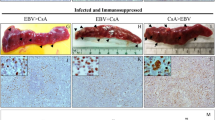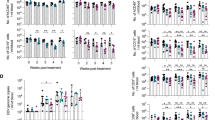Abstract
EPSTEIN–BARR VIRUS (EBV) has been associated with several diseases, including infectious mononucleosis (IM), Burkitt's lymphoma, and nasopharyngeal carcinoma. If EBV has an aetiological role in more than one of these diseases, explanations for pathogenic plurality must be sought. Host and environmental factors may influence the outcome of EBV infection, but recent descriptions of different EBV ‘strains’ have focused attention on the possibility that different virus strains may be associated with each of the above diseases1–3. Although virus strains have not been differentiated by antigenic expression4, two major biological patterns have been delineated5–7—strains capable of ‘transforming’ human cord blood lymphocytes to Epstein–Barr nuclear antigen (EBNA) positivity and ‘immortalised’ growth characteristics, and strains which lack this capability. In particular, the rare viral particles contained in throat washings from patients with active IM or Burkitt's lymphoma have such in vitro transforming capabilities8–10. Until now, however, sufficient virus for biochemical study has been obtained from only two continuous lymphoblastoid cell lines. Fortuitously, the viruses from these two lines have different biological properties. The B95-8 cell line produces a virus with transforming characteristics which was originally derived from the peripheral blood of a patient with transfusion-induced IM, and was passaged and maintained in lymphocytes of the cotton-topped marmoset11. It is possible, however, that deletion or addition of nucleotide sequences has occurred as a result of the continued propagation of this virus in the cells of a subhuman primate. A second virus strain is produced by the P3HR1 cell line. This cell line was originally derived from the JlJoye Burkitt's lymphoma cell line by soft agar cloning12. The virus produced by this cell line is generally incapable of in vitro ‘transformation’5,6, but will induce early antigen (EA) in the EBV genome-positive non-producing RAJI cell line13. EBV produced during early passage(s) of the original P3HR1 cell line had in vitro ‘transforming’ capability14, but subseqeuntly lost this property. Studies by Zur Hausen15 have suggested that a P3HR1 cell line produces a mixture of EBNA transforming and EA-inducing virus. This raises the possibility of a mutation in the P3HR1 virus and concern regarding its use as a prototype or ‘reference’ strain of EBV. We report here the isolation of a new tumour-derived strain of EBV which has been propagated only in its cell of origin, and which manifests in vitro ‘transforming’ capability, making it a more representative ‘wild-type’ or putative tumour virus strain of EBV.
This is a preview of subscription content, access via your institution
Access options
Subscribe to this journal
Receive 51 print issues and online access
$199.00 per year
only $3.90 per issue
Buy this article
- Purchase on Springer Link
- Instant access to full article PDF
Prices may be subject to local taxes which are calculated during checkout
Similar content being viewed by others
References
Ziegler, J. L., Magrath, I. T., Gerber, P. & Levine, P. H. Annls Inst. Med. 86, 323–336 (1977).
Klein, G. Bull. Cancer 63, 399–410 ( 1976).
Gerber, P., Nkrumah, F. K., Pritchett, R. & Kieff, E. Int. J. Cancer 17, 71–81 (1976).
Miller, G., Coope, D., Niederman, J. & Pagano, J. J. Virol. 18, 1071–1080 (1976).
Miller, G., Robinson, J. & Heston, L. Cold Spring Harbor Symp. quant. Biol. 39, 773–781 (1974).
Miller, G., Robinson, J., Heston, L. & Lipman, M. Proc. natn. Acad. Sci. U.S.A. 71, 4006–4010 (1974).
Menzes, J., Leibold, W. & Klein, G. Expl Cell Res. 92, 478–484 (1975).
Gerber, P. et al. Lancet ii, 988–989 (1972).
Miller, G., Niederman, J. C. & Andrews, L. L. New Engl. J. Med. 288, 229–232 (1973).
Pereira, M. S., Field, A. M. & Blake, M. M. Lancet i, 710–711 (1972).
Miller, G. & Lipman, M. Proc. natn. Acad. Sci. U.S.A. 70, 190–194 (1973).
Hinuma, Y. et al. J. Virol. 1, 1045–1051 (1967).
Henle, W. et al. Science 169, 188–190 (1970).
Gerber, P., Whang-Peng, J. & Monroe, J. H. Proc. natn. Acad. Sci. U.S.A. 63, 740–747 (1969).
Zur Hausen, H. in Third Int. Symp. Oncogenesis and Herpesviruses. Cambridge, Mass., July 25–29 (1911).
Sugden, B., Summers, W. C. & Klein, G. J. Virol. 18, 765–775 (1976).
Pritchett, R. F., Hayward, S. D. & Kieff, E. D. J. Virol. 15, 556–569 (1975).
Reed, L. J. & Muench, H. Am. J. Hyg. 27, 493–497 (1938).
Chattopadhyay, S. K., Lowy, D. R., Teich, N. M., Levine, A. S. & Rowe, W. P. Cold Spring Harb. Symp. quant. Biol. 39, 1085–1101 (1974).
Author information
Authors and Affiliations
Rights and permissions
About this article
Cite this article
PIZZO, P., MAGRATH, I., CHATTOPADHYAY, S. et al. A new tumour-derived transforming strain of Epstein–Barr virus. Nature 272, 629–631 (1978). https://doi.org/10.1038/272629a0
Received:
Accepted:
Issue Date:
DOI: https://doi.org/10.1038/272629a0
This article is cited by
Comments
By submitting a comment you agree to abide by our Terms and Community Guidelines. If you find something abusive or that does not comply with our terms or guidelines please flag it as inappropriate.



